Swans Trust News
First Team Player
- Joined
- Oct 21, 2020
- Messages
- 289
- Reaction score
- 0
It was with great pleasure, that the Trust officially unveiled the latest piece of street art to permanently commemorate legends of Swansea Town/City and Wales. Entitled, ‘The Alice Street Boys’, the artwork recognises the astonishing contribution that one small Swansea street played in the development of five Welsh international players.
The scheme is part of a larger project by The Swans Trust to promote the history and heritage of the football club, and following on from the unveiling of the street art tribute to the Allchurch Brothers last October, yesterday it was the turn to commemorate the incredible and unique story of The Alice Street Boys, five young men from a street in Cwmdu, who all represented Wales in just 13 short years from 1946. It is a story utterly unique in the history of football and the Trust is delighted to be able recognise this hugely important story of not just Swansea and Welsh football, but British football too.
The players – Ernie Jones, Jackie Roberts, John Charles, Mel Charles and Mel Nurse – not only represented Wales, they also enjoyed careers representing some of the game’s biggest clubs.
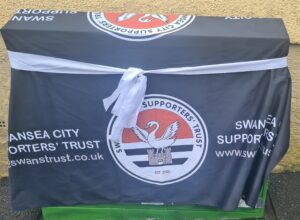
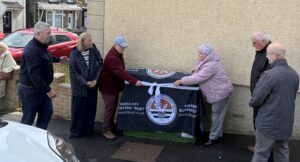
The first to be capped by Wales from Alice Street was Ernie Jones. He had already played for Wales in a wartime international, but in October 1946, he won the first of his four Welsh caps when he was selected to play against Scotland at The Racecourse, Wrexham. Including his wartime appearances for Swansea Town, Ernie played 139 times for the club, scoring 23 goals. At the end of the 1946-47 season, the club’s directors sold him to Tottenham against the wishes of then manager, Haydn Green. Ernie would eventually play for Southampton and Bristol City before ending his career at Rhyl FC in 1954.
The second Alice Street boy to play for Wales was Ernie’s best friend and next-door neighbour, Jackie Roberts. Ernie lived at 10 Alice Street with Jackie next door at number 9, and in 1938, both had been scouted at Cwmbwrla Park by Bob Thomas of First Division Bolton Wanderers. Both signed for the club, Ernie as an amateur, who would soon return to Swansea Town, but Jackie signed full professional forms and remained in Bolton. In Jackie’s first full game for the club, against Everton at Burnden Park in 1938, in front of a home crowd of 58,000, Jackie scored a hat-trick, becoming an instant fans favourite. His career with Bolton in Division One, eventually as captain for four seasons, would last until 1951. Sadly, Jackie lost 7 years of his career – and the sight in one eye, due to wartime fighting in Italy in WWII – but would amazingly still be picked to play for Wales in 1949. As part of Wales’s first ever official overseas tour, Jackie was selected to play against Belgium, where injury forced him out of selection for the final match against Switzerland. In 1951, Jackie was transferred from Bolton back to Swansea, where his only season with the Swans was ended by knee injuries, which led to his premature retirement from the game.
The Charles family had initially lived with the Roberts family in 9 Alice Street (John & Mel’s mother & Jackie Robert’s mother were sisters), before the Charles family moved to number 6. John would make his Wales debut in 1950 in the 0-0 draw against Northern Ireland at the Racecourse, aged just 18. By then, of course, despite having spent two years on the Swans ground staff at the Vetch, and playing for the club in the Welsh League, John was spotted – again on Cwmbwrla Park – this time by Leeds United scout, Alf Pickard, and he was snatched away to Yorkshire. John would become, arguably, Wales’s greatest player, winning 38 caps, also creating legendary status for himself in the history of Juventus, where he is still revered to this day.
1955 saw the Wales debut of John’s younger brother, Mel Charles, when he was selected to play for Wales against Northern Ireland at Windsor Park. By then, Mel had become a mainstay of Swansea Town’s team as an attacking and free scoring wing half. His success at Swansea and with Wales would lead to a move to Arsenal in 1959, for a British Transfer Record. Often in the shadow of his illustrious brother, by the time he left the Swans with 233 league appearances, Mel had, nevertheless, been voted into the Team of the Tournament at the 1958 World Cup, and had cemented himself as one of the best players in the world. His 31 Wales caps would have been many more but for knee injuries at Arsenal which would prematurely end his career aged just 30 after a short spell at Cardiff City.
Finally, in 1959 against England at Ninian Park, Mel Nurse, latterly of no 3 Alice Street, became the fifth member of this extraordinary street to play internationally. Mel would go on to win 12 caps for Wales, ironically being denied more appearances due to a fellow Alice Street resident. In the days of no substitutes, Mel often only played when his neighbour, John Charles, was unavailable due to issues at Juventus. Despite this, Mel played at every available Welsh level at the time – Schoolboys, Under 23 and full international – before eventually being sold, against his wishes, by the Swans to Middlesbrough in 1962. He returned to the club – via Swindon Town – in 1968, where he would eventually guide the club to promotion from Division Four. Despite his legendary status as a captain for the Swans, it is for his role in twice saving the club from closure in the mid 1980’s and early 2000’s, that Mel rightly carries the tag, ‘Mr Swansea’.
Between them, these five Alice Street lads won an amazing 86 international caps for Wales, made 2,064 professional appearances, scoring 481 goals, all from five insignificant terraced houses on one small, working class Swansea street, it is truly an astonishing footballing achievement.
A great crowd attended yesterday at Alice Street to watch the artwork being unveiled by the son & daughter of Jackie Roberts, (Leighton and Vivienne) the brother of John & Mel Charles, (Malcolm), and Mel Charles’s daughter, (Catherine). The players were also represented by their grandchildren and great grandchildren, along with friends and neighbours of the families & local councilors. Members of the Trust Board and Swansea City were also present to pay tribute and the presentation ceremony was conducted by Swans Trust Supporter Director, Paul Meller and Trust Ambassador, David Brayley.
It was a true community event which celebrated the careers of these greats of Welsh football in fitting style with Paul Meller stating “A key objective for the Trust is to celebrate the club and city’s footballing history and heritage. Through painting street cabinets with artwork of former Swans and Wales internationals close to where they lived or were associated, we hope that it will act as a source of pride in the local community and be an inspiration to future generations of footballers.
“We have more in the pipeline and will be announcing more details of these in the coming weeks”
Amongst some of the families attending this unveiling Malcolm Charles, brother of John and Mel Charles said: ‘This has been a lovely event and such a fitting tribute to my brothers who both loved Alice Street. My family are extremely grateful to all at the Swans Trust for creating this tribute to them, it is really special.’
 And Leighton Roberts, son of Jackie Roberts added, ‘This is the first tribute to my father and his football career. As a family, we have always been so proud of his career, and are delighted with the artwork – it is outstanding – and we are very grateful to the Swans Trust for creating this tribute to our dad and his footballing mates from the real brylcream days of football and for keeping their memories alive’
And Leighton Roberts, son of Jackie Roberts added, ‘This is the first tribute to my father and his football career. As a family, we have always been so proud of his career, and are delighted with the artwork – it is outstanding – and we are very grateful to the Swans Trust for creating this tribute to our dad and his footballing mates from the real brylcream days of football and for keeping their memories alive’
If you would like to learn more about the players commemorated by the Trust yesterday, the film – Wonderland, The Alice Street Story – is available to watch for free, here:
David Brayley, Ambassador
Swansea City Supporters’ Trust
5th August 2025
“Join the Trust”




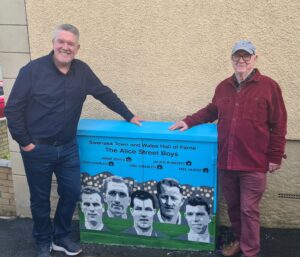
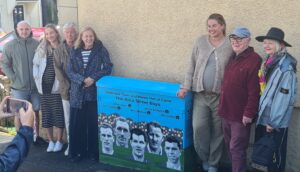
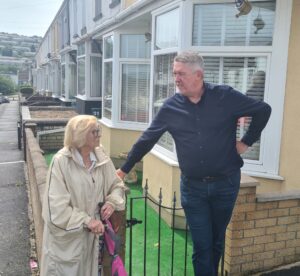
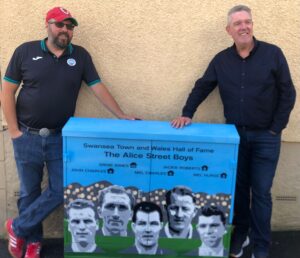
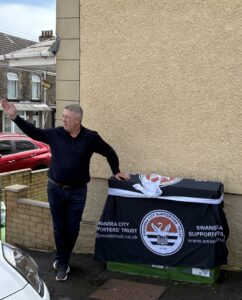
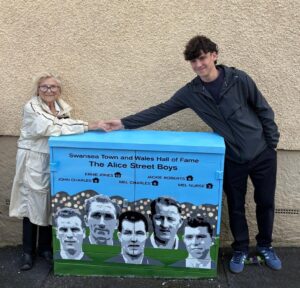
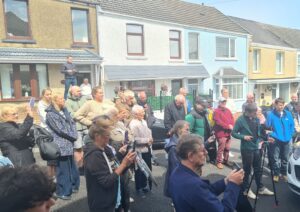

The post Swans Trust Unveil Tribute to Alice Street Boys appeared first on Swansea City Supporters' Trust.
Continue reading...
The scheme is part of a larger project by The Swans Trust to promote the history and heritage of the football club, and following on from the unveiling of the street art tribute to the Allchurch Brothers last October, yesterday it was the turn to commemorate the incredible and unique story of The Alice Street Boys, five young men from a street in Cwmdu, who all represented Wales in just 13 short years from 1946. It is a story utterly unique in the history of football and the Trust is delighted to be able recognise this hugely important story of not just Swansea and Welsh football, but British football too.
The players – Ernie Jones, Jackie Roberts, John Charles, Mel Charles and Mel Nurse – not only represented Wales, they also enjoyed careers representing some of the game’s biggest clubs.


The first to be capped by Wales from Alice Street was Ernie Jones. He had already played for Wales in a wartime international, but in October 1946, he won the first of his four Welsh caps when he was selected to play against Scotland at The Racecourse, Wrexham. Including his wartime appearances for Swansea Town, Ernie played 139 times for the club, scoring 23 goals. At the end of the 1946-47 season, the club’s directors sold him to Tottenham against the wishes of then manager, Haydn Green. Ernie would eventually play for Southampton and Bristol City before ending his career at Rhyl FC in 1954.
The second Alice Street boy to play for Wales was Ernie’s best friend and next-door neighbour, Jackie Roberts. Ernie lived at 10 Alice Street with Jackie next door at number 9, and in 1938, both had been scouted at Cwmbwrla Park by Bob Thomas of First Division Bolton Wanderers. Both signed for the club, Ernie as an amateur, who would soon return to Swansea Town, but Jackie signed full professional forms and remained in Bolton. In Jackie’s first full game for the club, against Everton at Burnden Park in 1938, in front of a home crowd of 58,000, Jackie scored a hat-trick, becoming an instant fans favourite. His career with Bolton in Division One, eventually as captain for four seasons, would last until 1951. Sadly, Jackie lost 7 years of his career – and the sight in one eye, due to wartime fighting in Italy in WWII – but would amazingly still be picked to play for Wales in 1949. As part of Wales’s first ever official overseas tour, Jackie was selected to play against Belgium, where injury forced him out of selection for the final match against Switzerland. In 1951, Jackie was transferred from Bolton back to Swansea, where his only season with the Swans was ended by knee injuries, which led to his premature retirement from the game.
The Charles family had initially lived with the Roberts family in 9 Alice Street (John & Mel’s mother & Jackie Robert’s mother were sisters), before the Charles family moved to number 6. John would make his Wales debut in 1950 in the 0-0 draw against Northern Ireland at the Racecourse, aged just 18. By then, of course, despite having spent two years on the Swans ground staff at the Vetch, and playing for the club in the Welsh League, John was spotted – again on Cwmbwrla Park – this time by Leeds United scout, Alf Pickard, and he was snatched away to Yorkshire. John would become, arguably, Wales’s greatest player, winning 38 caps, also creating legendary status for himself in the history of Juventus, where he is still revered to this day.
1955 saw the Wales debut of John’s younger brother, Mel Charles, when he was selected to play for Wales against Northern Ireland at Windsor Park. By then, Mel had become a mainstay of Swansea Town’s team as an attacking and free scoring wing half. His success at Swansea and with Wales would lead to a move to Arsenal in 1959, for a British Transfer Record. Often in the shadow of his illustrious brother, by the time he left the Swans with 233 league appearances, Mel had, nevertheless, been voted into the Team of the Tournament at the 1958 World Cup, and had cemented himself as one of the best players in the world. His 31 Wales caps would have been many more but for knee injuries at Arsenal which would prematurely end his career aged just 30 after a short spell at Cardiff City.
Finally, in 1959 against England at Ninian Park, Mel Nurse, latterly of no 3 Alice Street, became the fifth member of this extraordinary street to play internationally. Mel would go on to win 12 caps for Wales, ironically being denied more appearances due to a fellow Alice Street resident. In the days of no substitutes, Mel often only played when his neighbour, John Charles, was unavailable due to issues at Juventus. Despite this, Mel played at every available Welsh level at the time – Schoolboys, Under 23 and full international – before eventually being sold, against his wishes, by the Swans to Middlesbrough in 1962. He returned to the club – via Swindon Town – in 1968, where he would eventually guide the club to promotion from Division Four. Despite his legendary status as a captain for the Swans, it is for his role in twice saving the club from closure in the mid 1980’s and early 2000’s, that Mel rightly carries the tag, ‘Mr Swansea’.
Between them, these five Alice Street lads won an amazing 86 international caps for Wales, made 2,064 professional appearances, scoring 481 goals, all from five insignificant terraced houses on one small, working class Swansea street, it is truly an astonishing footballing achievement.
A great crowd attended yesterday at Alice Street to watch the artwork being unveiled by the son & daughter of Jackie Roberts, (Leighton and Vivienne) the brother of John & Mel Charles, (Malcolm), and Mel Charles’s daughter, (Catherine). The players were also represented by their grandchildren and great grandchildren, along with friends and neighbours of the families & local councilors. Members of the Trust Board and Swansea City were also present to pay tribute and the presentation ceremony was conducted by Swans Trust Supporter Director, Paul Meller and Trust Ambassador, David Brayley.
It was a true community event which celebrated the careers of these greats of Welsh football in fitting style with Paul Meller stating “A key objective for the Trust is to celebrate the club and city’s footballing history and heritage. Through painting street cabinets with artwork of former Swans and Wales internationals close to where they lived or were associated, we hope that it will act as a source of pride in the local community and be an inspiration to future generations of footballers.
“We have more in the pipeline and will be announcing more details of these in the coming weeks”
Amongst some of the families attending this unveiling Malcolm Charles, brother of John and Mel Charles said: ‘This has been a lovely event and such a fitting tribute to my brothers who both loved Alice Street. My family are extremely grateful to all at the Swans Trust for creating this tribute to them, it is really special.’
 And Leighton Roberts, son of Jackie Roberts added, ‘This is the first tribute to my father and his football career. As a family, we have always been so proud of his career, and are delighted with the artwork – it is outstanding – and we are very grateful to the Swans Trust for creating this tribute to our dad and his footballing mates from the real brylcream days of football and for keeping their memories alive’
And Leighton Roberts, son of Jackie Roberts added, ‘This is the first tribute to my father and his football career. As a family, we have always been so proud of his career, and are delighted with the artwork – it is outstanding – and we are very grateful to the Swans Trust for creating this tribute to our dad and his footballing mates from the real brylcream days of football and for keeping their memories alive’If you would like to learn more about the players commemorated by the Trust yesterday, the film – Wonderland, The Alice Street Story – is available to watch for free, here:
David Brayley, Ambassador
Swansea City Supporters’ Trust
5th August 2025
“Join the Trust”












The post Swans Trust Unveil Tribute to Alice Street Boys appeared first on Swansea City Supporters' Trust.
Continue reading...
